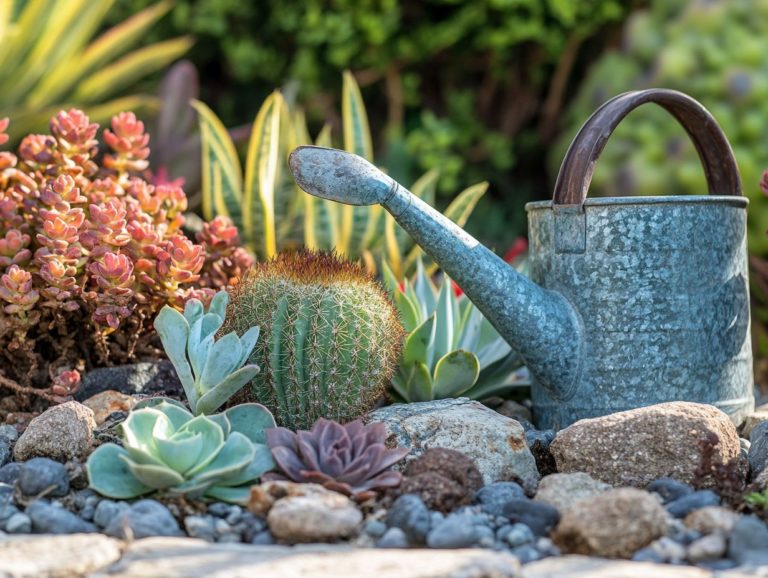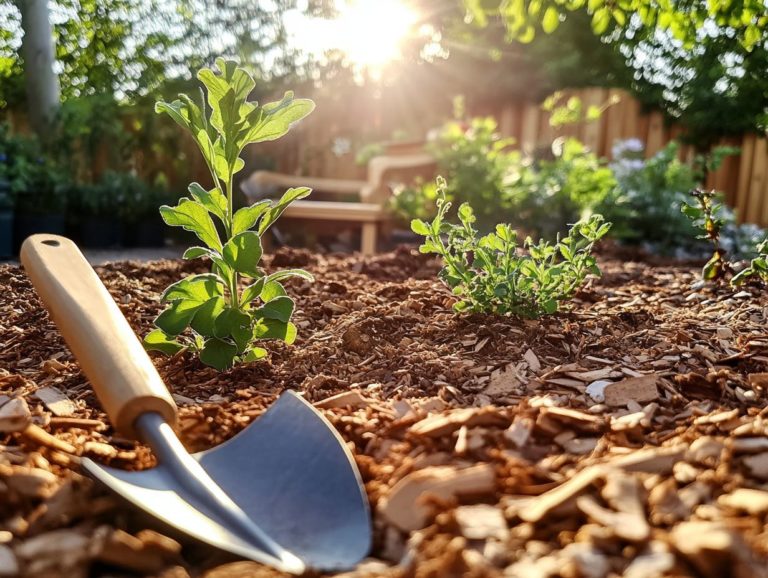How to Prune Drought-Resistant Plants?
Drought-resistant and drought-tolerant plants are excellent choices if you’re aiming to conserve water while still enjoying a vibrant landscape.
Understanding what allows these plants to flourish is your first step toward successful gardening. This article delves into the significance of pruning, the optimal times to carry it out, and the appropriate tools and techniques to employ in drought-tolerant gardening.
It also offers tailored strategies for various drought-resistant species and points out common mistakes you should avoid. Dive into this information to boost your gardening skills and ensure your plants remain healthy and thriving!
Contents
- Key Takeaways:
- Understanding Drought-Resistant Plants
- Why Prune Drought-Resistant Plants?
- When to Prune Drought-Resistant Plants
- Tools and Techniques for Pruning
- Pruning Strategies for Different Types of Drought-Resistant Plants
- Maintaining Pruned Drought-Resistant Plants
- Common Mistakes to Avoid
- Frequently Asked Questions
- What are drought-resistant plants?
- Why is pruning important for drought-resistant plants?
- When is the best time to prune drought-resistant plants?
- How should I prune drought-resistant plants?
- Are there any special considerations when pruning drought-resistant plants?
- Can pruning help drought-resistant plants conserve water?
- Pruning Pitfalls and How to Avoid Them
Key Takeaways:

- Understanding the characteristics of drought-resistant plants is essential for proper pruning.
- Pruning these plants has numerous benefits, including promoting healthier growth and conserving water.
- Knowing the best times to prune and having the right tools and techniques are crucial for successful pruning.
Understanding Drought-Resistant Plants
Understanding drought-resistant plants is vital for your gardening success, especially in areas like Southern California, where water conservation and drought tolerance are paramount due to frequent droughts. These remarkable plants, often called plants that thrive in dry conditions, are uniquely adapted to flourish on less water while retaining their beauty and structural integrity in challenging environments.
By choosing the right landscape plants, you can cultivate a vibrant, low-maintenance garden that flourishes even amidst heat and drought stress. This approach enhances your garden’s aesthetic appeal and contributes positively to the environment with every water-wise choice and effective drought gardening practice you make.
What Makes a Plant Drought-Resistant?
Plants are classified as drought-resistant because of their remarkable ability to endure extended periods of drought stress. This resilience stems from specific adaptations, such as efficient water storage mechanisms and deep-root systems that allow them to tap into deeper moisture sources.
These traits, along with biological factors like leaf structure and stomatal regulation, are crucial for minimizing water loss. The waxy cuticle on leaves significantly reduces evaporation, while the ability to close stomata during critical moments effectively conserves moisture.
Ecologically, the environment surrounding a plant also plays a vital role in its drought tolerance. Soils rich in organic matter and good drainage contribute to healthier root systems. You can enhance drought resilience through proper soil conditioning, employing techniques such as organic mulch, mulching, and adding compost.
Consider examples of drought-tolerant plants, like succulents such as Aloe vera and native grasses, as well as Agapanthus and Anchusa azurea. These remarkable specimens showcase their ability to thrive even in the most challenging conditions, embodying the essence of adaptation and survival.
Why Prune Drought-Resistant Plants?
Pruning drought-resistant plants is a vital aspect of plant care that refines their shape and aesthetic appeal while boosting their overall health. Additionally, knowing when to water drought-resistant plants is essential in the realm of drought-tolerant gardening.
When you prune effectively, your plants are better equipped to endure heat stress and drought, allowing them to remain vibrant and productive even during challenging conditions.
Start your drought-tolerant garden today and make a positive impact on the environment!
Benefits of Pruning
The benefits of pruning drought-resistant plants go beyond mere aesthetics. It plays a crucial role in water conservation by optimizing how these plants absorb moisture and minimizing overall water demand in gardening techniques for dry conditions.
By thoughtfully trimming back excessive growth, you can encourage enhanced vitality in these resilient species. This allows them to allocate resources more effectively.
This approach not only fortifies their structure but also boosts their resistance to diseases. A well-pruned plant promotes better air circulation and sunlight penetration, creating a healthier environment.
Take succulents like Agave or Yucca, for instance. With careful management through strategic pruning, these drought-tolerant plants develop a stronger root system that allows them to store water more efficiently and distribute nutrients throughout their structure even when conditions are less than favorable.
When to Prune Drought-Resistant Plants

Knowing the right time to prune can make a big difference for your plants! Understanding how to winterize drought-resistant gardens is crucial for maintaining their health and vitality. Act at the right moments for pruning; the optimal times often align with seasonal growth patterns and the distinct challenges that drought conditions present.
Generally, late winter or early spring emerges as the perfect timeframe. Pruning during this period encourages robust growth when the plant is poised to flourish after its dormant period.
Best Times for Pruning
The best times to prune drought-resistant plants typically align with their growing seasons, often in late winter or early spring. For effective maintenance, consider winter care for drought-resistant plants to ensure they are less vulnerable to drought stress and heat stress during critical growth periods.
This strategic timing is essential as it allows the plants to bounce back quickly and minimize stress as temperatures start to rise. For instance, many succulents respond splendidly to a light prune just before their active growth season. This season can vary from early spring to late summer depending on the species.
By pruning strategically, you re supporting healthier growth and enhancing the plants drought resilience. This improvement in air circulation and light penetration can make a world of difference. Properly maintained, these plants will be better equipped to withstand the harsh conditions of peak summer, ensuring they remain vibrant and robust throughout the dry season.
Tools and Techniques for Pruning
Utilizing the right tools and techniques for pruning is essential for effective care of drought-tolerant plants. This practice enhances both their health and your water conservation efforts, which is vital for sustainable gardening techniques for dry conditions. Equipping yourself with essential tools like sharp shears, loppers, and pruning saws enables you to make clean cuts that minimize stress and promote recovery in drought-stressed plants.
This thoughtful approach benefits your plants while also contributing to a more sustainable gardening practice.
Essential Tools and Proper Techniques
The essential tools for effective pruning in your garden include sharp bypass pruners, loppers, and saws. When combined with the right techniques, you’ll significantly enhance your drought-tolerant gardening practices.
These instruments play a vital role in shaping and maintaining the health of your plants. Bypass pruners are ideal for making clean cuts on live stems, promoting faster healing and helping to prevent disease. Loppers are your go-to for tackling thicker branches, effectively thinning crowded areas, which is crucial for ensuring adequate airflow and sunlight penetration.
Saws are critical for removing larger limbs, helping to shape the overall structure of your plants. When used properly, these tools encourage deeper root systems and reduce competition for resources in the surrounding environment, boosting resilience against drought.
Regular and thoughtful pruning not only enhances the aesthetic appeal of your garden but also fosters a thriving ecosystem capable of withstanding dry conditions.
Now is the time to check your tools and start pruning your drought-resistant plants for a healthier garden!
Pruning Strategies for Different Types of Drought-Resistant Plants
Implementing tailored pruning strategies for various drought-resistant plants is key to ensuring their health and longevity. This is especially true for succulents, cacti, and other drought-tolerant varieties that flourish in arid conditions. To learn more about care techniques, check out this guide on how to revive drought-resistant plants.
By understanding the unique needs of each plant type, you can enhance their resilience and beauty, allowing them to thrive in even the toughest climates.
Specific Tips for Succulents, Cacti, and Other Plants

When you re pruning succulents and cacti, such as Cotyledon orbiculata or Pittosporum tenuifolium, it s key to adopt specific techniques. Using clean, sharp tools is essential to prevent disease. Making cuts at the correct angle encourages healthy growth in these drought-tolerant varieties.
These specialized trimming methods consider their unique growth patterns and water-storage capabilities. For instance, when working with succulents, cutting just above a leaf node the point where a leaf meets the stem can stimulate new growth. Cacti, on the other hand, demand thinner, more precise incisions to avoid damaging their thick skin.
Care tips also highlight the importance of allowing your plants to dry out after pruning. This practice helps prevent rot and ensures they maintain their resilience in dry conditions. Regularly assessing their light and watering needs, including deep watering practices, further enhances their overall health. This leads to vibrant, thriving specimens.
Maintaining Pruned Drought-Resistant Plants
Maintaining pruned drought-resistant plants is essential for keeping them healthy and vibrant. You’ll want to employ effective post-pruning care strategies that prioritize water conservation while encouraging robust growth.
After you prune, you must monitor your plants closely and adjust your care routines to support their recovery. By doing so, you ll ensure they thrive and flourish in their environment.
Post-Pruning Care and Maintenance
Post-pruning care and maintenance for drought-resistant plants require your diligent attention to watering and nutrients, ensuring they thrive even when water is scarce.
To optimize water conservation, adopting efficient watering techniques is vital:
- Drip irrigation
- Soaker hoses
These methods deliver moisture directly to the roots, minimizing waste. Applying mulch around the base of each plant not only retains moisture but also suppresses weeds vying for resources. Opting for organic mulches, such as wood chips or straw, can enrich your soil as they break down, enhancing the ecosystem of your garden.
Vigilance regarding pests is essential. Employing integrated pest management strategies like introducing beneficial insects or using organic repellents will shield your resilient plants from infestations that could cause further stress.
By embracing these practices, you can cultivate a thriving garden, even in the face of adversity. Are you ready to transform your garden into a thriving oasis?
Common Mistakes to Avoid
Avoiding common mistakes during the pruning process is crucial for preserving the health of drought-tolerant plants. These missteps can introduce unnecessary stress, ultimately hindering the plants’ ability to flourish in water-scarce environments.
Prioritizing careful pruning ensures that your plants remain resilient and vibrant, even in challenging conditions. With these steps, you have the power to cultivate a vibrant, resilient garden!
Frequently Asked Questions
Here are some common questions about caring for drought-resistant plants:

What are drought-resistant plants?
Drought-resistant plants, or plants that can survive with little water, are specially adapted to thrive in dry, arid conditions.
Why is pruning important for drought-resistant plants?
Pruning helps maintain the health and appearance of these plants by removing dead or damaged branches, promoting new growth, and managing their size and shape.
When is the best time to prune drought-resistant plants?
The best time to prune these plants is during their dormant period, typically in late winter or early spring before new growth begins.
How should I prune drought-resistant plants?
Use clean and sharp tools to prevent disease spread. Cut back any dead or damaged branches just above a healthy bud or branch, and trim overgrown or crowded areas.
Are there any special considerations when pruning drought-resistant plants?
Yes, remember that these plants are adapted to survive in dry conditions. Avoid over-pruning, as it can reduce their ability to conserve water.
Can pruning help drought-resistant plants conserve water?
Yes, pruning can help conserve water by removing excess foliage and decreasing their overall water needs. However, be careful not to over-prune, as this can hinder their ability to photosynthesize and conserve water.
Pruning Pitfalls and How to Avoid Them
Pruning pitfalls can range from over-pruning to mistiming your cuts. Understanding how to navigate these missteps is crucial for effectively caring for plants that can survive with little water and maintaining their optimal health.
By examining the pruning process closely, you can spot common blunders, such as using dull tools that inflict unnecessary harm. Failing to research each plant’s specific needs before starting your trimming adventure is another pitfall. Improper techniques, like topping (cutting the top of the plant) or shearing (trimming the ends), can stress these plants, undermining their natural resilience.
To avoid these issues, keep your tools sharp and sanitized, and familiarize yourself with each plant’s growth patterns. Ensure that cuts are made at just the right time. Regular monitoring and gentle care improve the health of these plants while enhancing their appearance, creating flourishing landscapes even in challenging conditions.
Ready to transform your garden? Let s dive into the world of pruning, where a little care goes a long way! Start pruning today and watch your garden thrive like never before!






